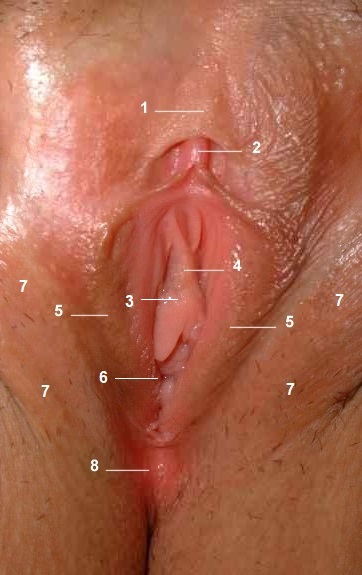A hand roadmap to the clitoris. 1. Clitoral hood (prepuce); 2. Clitoral glans; 3. Urethral opening;
4. Vulval vestibule; 5. Labia minora; 6. Vaginal opening; 7. Labia majora (hair removed); 8. Perineum
But the clitoris doesn't stop there (contrary to what all my anatomy textbooks said!). While the glans is certainly the most readily apparent part of the clit, it has additional structures that extend through the labia majora and around the vagina opening.The clitoris is a complex structure, with both internal AND external components, and its size and sensitivity can vary greatly from person to person. The clit as a whole is estimated to have more than 8,000 nerve endings, more than any other place in the human body (even the head of the male penis).
The internal structures of the clitoris. Note that the clitoral hood and labia minora
and majora are left transparent in this illustration.
The internal portion of the clitoris forms a wishbone or wing-like structure that contains the corpus cavernosum - spongey erectile tissue similar to that in the shaft of the male penis. When aroused, these fill with blood and cause clitoral erection. That's right, we get ladyboners.
This totally would be his sex face.
The corpus cavernosum extends several centimeters before branching into a pair of crura (legs) called the crus clitoris. These crura are concealed behind the labia minora and follow along behind it to meet at the fourchette (the lowest point of the vulva where the labia fade into the perineum or "taint").
Related to the clitoris, but actually a separate structure, are the vestibular bulbs, which are made up of the same erectile tissue. These bulbs lie close to the crura on either side of the vaginal opening, beneath the labia majora. When aroused, these bulbs fill with blood and cause the vulva to swell outward.
All right. Now that we know what it IS, let's talk about what it DOES.
The clit apparently exists for one reason: female orgasm. Unlike the male penis, which is required for reproduction and urination, the clit serves no direct reproductive purpose (as female orgasm isn't required for conception) and no bodily function. It's a pleasure center.
Just like Robert Downey Jr, it exists just to make you happy.
The majority of women (70-80%) achieve orgasm only through direct clitoral stimulation - that is, fingers or mouth stimulating the clitoral glans, hood, or shaft. Because the glans itself is so packed with nerve endings, direct contact with it can be uncomfortable or even painful, so many women prefer indirect stimulation of the glans through the hood or labia.
For a long time, famous psychologist and all-around jerk Sigmund Freud postulated that there were 2 types of female orgasm - the clitoral and the vaginal. He said that the clitoral orgasm was immature and adolescent and that sexually mature women would be able to orgasm through vaginal penetration alone. His ideas persisted until Alfred Kinsey challenged them during his studies of human sexuality in the 30s, 40s, and 50s. Kinsey observed female masturbation techniques and found that the vast majority could not orgasm vaginally, and that very few even bothered to insert fingers or objects into their vaginas while masturbating; they focused instead on the clitoris. He eventually concluded that vaginal orgasms were nearly physiologically impossible because the vagina has so few nerve endings compared to the clitoris.
Later, Masters and Johnson built off Kinsey's research and discovered those crus clitoris which extend behind and within the labia. They discovered that vaginal orgasms and clitoral orgasms share the exact same stages of physical response, and reasoned that the so-called vaginal orgasm was the result of indirect clitoral stimulation, such as the clitoral hood rubbing the clitoris during penetrative sex and stimulation of the internal portions of the clitoris.
A demonstration. This is totally his sex face, too.
That seems like a good image to leave you with for this week... Next week, we move on to internal reproductive anatomy.





<- bro, Almighty God's universe is bigger.
ReplyDeleteYou gotta wee-wee...
yet, with humility,
you can N will grow to enormity.
This is revisionist history. Masters and Johnson didn’t discover the crura; these were mapped in the 1800’s. Both penis and clitoris have crura, which simply attach the organ to the pubic bones and have no role in triggering orgasm. They have no nerves, and thus cannot be stimulated during intercourse. Masters and Johnson never mentioned stimulation of the “internal portions of the clitoris.” This is part of the neo-Freudian pseudo-science that is being cobbled together to once again glorify penile intercourse as the key to female orgasm. Prepare for more faked orgasms by women under pressure to “come the right way.”
ReplyDeleteperde modelleri
ReplyDeletesms onay
Vodafone Mobil Ödeme Bozdurma
nft nasıl alınır
ankara evden eve nakliyat
trafik sigortasi
dedektör
websitesi kurmak
Aşk kitapları
ataşehir toshiba klima servisi
ReplyDeletependik beko klima servisi
tuzla alarko carrier klima servisi
tuzla daikin klima servisi
ataşehir beko klima servisi
kadıköy daikin klima servisi
kartal toshiba klima servisi
beykoz daikin klima servisi
üsküdar daikin klima servisi